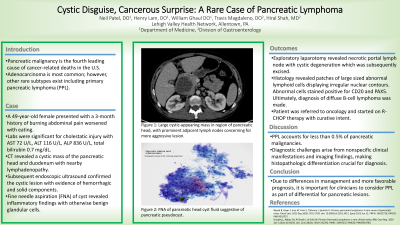Back


Poster Session B - Monday Morning
Category: Biliary/Pancreas
B0044 - Cystic Disguise, Cancerous Surprise: A Rare Case of Pancreatic Lymphoma
Monday, October 24, 2022
10:00 AM – 12:00 PM ET
Location: Crown Ballroom

Has Audio

Neil Patel, DO
Lehigh Valley Health Network
Allentown, PA
Presenting Author(s)
Neil Patel, DO1, Henry Lam, DO1, William Ghaul, DO1, Travis Magdaleno, DO1, Hiral Shah, MD2
1Lehigh Valley Health Network, Allentown, PA; 2LVHN/EPGI, Allentown, PA
Introduction: Pancreatic cancer is an extraordinarily aggressive and devastating form of malignancy serving as the fourth leading cause of cancer related deaths in the United States. The most common subtype is adenocarcinoma; however, other subtypes of pancreatic neoplasms exist, including primary pancreatic lymphoma (PPL). Here we present a rare case of PPL masquerading as a pancreatic cyst.
Case Description/Methods: A 49-year-old female with a history of MALT lymphoma of the right eye presented with upper epigastric abdominal pain ongoing for the past three months. The pain was burning in nature that would worsen with eating. Associated symptoms included intermittent fevers and unintentional weight loss of ten pounds since the onset of symptoms. Labs were significant for abnormal liver function tests, including AST 72 U/L, ALT 116 U/L, ALP 836 U/L, total bilirubin 0.7 mg/dL. CT abdomen/pelvis revealed a 5.7 x 5.4 cm cystic mass of the pancreatic head and duodenum with nearby lymphadenopathy. Subsequent endoscopic ultrasound confirmed the cystic lesion with evidence of hemorrhagic and solid components. Pathology of FNA obtained specimen was suggestive of a pseudocyst. Given persistent pain, patient underwent exploratory laparotomy, revealing a necrotic portal lymph node with cystic degeneration adjacent to the duodenum, which was subsequently excised. A Whipple procedure was not performed. Biopsy results showed large sized abnormal lymphoid cells displaying irregular nuclear contours consistent with diffuse B-cell lymphoma. PET scan showed stage 1 disease with Ki-67 proliferation index of 90%. Patient was referred to oncology and started on R-CHOP therapy with curative intent.
Discussion: PPL is a rare malignancy, accounting for less than 0.5% of pancreatic cancer. Early diagnosis is challenging given that clinical presentations and imaging findings are nonspecific and commonly mimicking adenocarcinoma. As such, histopathological findings are crucial for differentiation. PPL responds well to chemotherapeutic regimens and portends a much more favorable prognosis with a 5-year survival rate of around 50% as compared to 11% for pancreatic adenocarcinoma. Therefore, it is important for clinicians to consider PPL as part of their differential for pancreatic lesions given the differences in management and outcomes.
Disclosures:
Neil Patel, DO1, Henry Lam, DO1, William Ghaul, DO1, Travis Magdaleno, DO1, Hiral Shah, MD2. B0044 - Cystic Disguise, Cancerous Surprise: A Rare Case of Pancreatic Lymphoma, ACG 2022 Annual Scientific Meeting Abstracts. Charlotte, NC: American College of Gastroenterology.
1Lehigh Valley Health Network, Allentown, PA; 2LVHN/EPGI, Allentown, PA
Introduction: Pancreatic cancer is an extraordinarily aggressive and devastating form of malignancy serving as the fourth leading cause of cancer related deaths in the United States. The most common subtype is adenocarcinoma; however, other subtypes of pancreatic neoplasms exist, including primary pancreatic lymphoma (PPL). Here we present a rare case of PPL masquerading as a pancreatic cyst.
Case Description/Methods: A 49-year-old female with a history of MALT lymphoma of the right eye presented with upper epigastric abdominal pain ongoing for the past three months. The pain was burning in nature that would worsen with eating. Associated symptoms included intermittent fevers and unintentional weight loss of ten pounds since the onset of symptoms. Labs were significant for abnormal liver function tests, including AST 72 U/L, ALT 116 U/L, ALP 836 U/L, total bilirubin 0.7 mg/dL. CT abdomen/pelvis revealed a 5.7 x 5.4 cm cystic mass of the pancreatic head and duodenum with nearby lymphadenopathy. Subsequent endoscopic ultrasound confirmed the cystic lesion with evidence of hemorrhagic and solid components. Pathology of FNA obtained specimen was suggestive of a pseudocyst. Given persistent pain, patient underwent exploratory laparotomy, revealing a necrotic portal lymph node with cystic degeneration adjacent to the duodenum, which was subsequently excised. A Whipple procedure was not performed. Biopsy results showed large sized abnormal lymphoid cells displaying irregular nuclear contours consistent with diffuse B-cell lymphoma. PET scan showed stage 1 disease with Ki-67 proliferation index of 90%. Patient was referred to oncology and started on R-CHOP therapy with curative intent.
Discussion: PPL is a rare malignancy, accounting for less than 0.5% of pancreatic cancer. Early diagnosis is challenging given that clinical presentations and imaging findings are nonspecific and commonly mimicking adenocarcinoma. As such, histopathological findings are crucial for differentiation. PPL responds well to chemotherapeutic regimens and portends a much more favorable prognosis with a 5-year survival rate of around 50% as compared to 11% for pancreatic adenocarcinoma. Therefore, it is important for clinicians to consider PPL as part of their differential for pancreatic lesions given the differences in management and outcomes.
Disclosures:
Neil Patel indicated no relevant financial relationships.
Henry Lam indicated no relevant financial relationships.
William Ghaul indicated no relevant financial relationships.
Travis Magdaleno indicated no relevant financial relationships.
Hiral Shah: Abbvie – Speakers Bureau.
Neil Patel, DO1, Henry Lam, DO1, William Ghaul, DO1, Travis Magdaleno, DO1, Hiral Shah, MD2. B0044 - Cystic Disguise, Cancerous Surprise: A Rare Case of Pancreatic Lymphoma, ACG 2022 Annual Scientific Meeting Abstracts. Charlotte, NC: American College of Gastroenterology.
